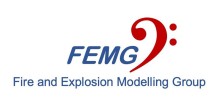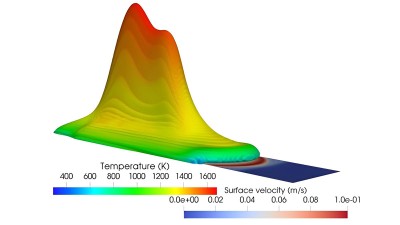

Fires in the built and natural environment
Fundamental combustion science is applied to study a wide range of fire scenarios with studies carried out for safety related reactive flows relevant to the petrochemical industry.
Overview

Our research covers a wide range of topics including:
- Fire dynamics
- Flame spread
- Façade fires
- Battery fires
- Glazing behaviour in fires
- Gas explosions.
Our expertise is primarily in computational fluid dynamics modelling of fire and explosions.
Specially developed sub-models
We apply fundamental combustion science to study a wide range of fire scenarios including liquid pool and gas burner fires, single and multi-phase jet fires, flame spread over solid and liquid fuels, façade fires as well as fires in buildings and tunnels using an in-house modified version of FireFOAM with the following specially developed sub-models:
- Extended the eddy dissipation concept for combustion to the large eddy simulation framework and modified the model to remove its deficiency in predicting pool fires as unphysically lifted from the flame base
- Developed a new soot model for fire simulations based on the laminar smoke point height concept and the partially stirred reactor approach
- Implemented in FireFOAM
- Two grey WSGGM: ‘grey Smith’ and ‘grey Cassol’
- Three multi-band WSGGM: ‘3-band Smith’, 4-band Cassol and ‘4-band Johansson’ - the ‘Grey Cassol’ and ‘4band Cassol’ both employ parameters data generated from the up-to-date HITEMP-2010 database (high temperature molecular spectroscopic database) for fixed specific values of the ratio of mole fractions of water vapour and carbon dioxide
- A 'box' model to incorporate the spectral characteristics of gaseous radiation for simulating the interaction between watermist and fires
- A coupled fluid-solid approach for upward flame spread incorporating pyrolysis, laminar to turbulent transition near the wall, in-depth radiation and surface regression
- Coupled numerical simulation of convective motions with the liquid fuel and fire dynamics, removing the need to specify mass burning rates when conducting computational fluid dynamics simulations of pool fires with dynamically predicted spatially resolved mass burning rates for combustion, soot and radioative heat transfer in fire simulations as well as dynamic predictions of mass burning rate of liquid pool fires
- 3D formulations have been developed to explicitly solve the transport equations in both phases - a compressible solver was formulated for flame propagation in the gas phase using a one-step chemical reaction expression and mixture-averaged diffusion coefficients for the gaseous species and an incompressible solver with temperature dependent thermo-physical properties was employed to describe the convective motions and heat transfer in the liquid fuel region.
Publications
Zhibin Chen, Jennifer Wen, Baopeng Xu, Siaka Dembele, Large eddy simulation of a medium-scale methanol pool fire using the extended eddy dissipation concept, J of Heat and Mass Transfer, Vol.70, March 2014, Pages 389-408
Zhibin Chen, Jennifer Wen, Baopeng Xu, Siaka Dembele, Extension of the eddy dissipation concept and smoke point soot model to the LES frame for fire simulations, Fire Safety J, 64, Feb. 2014, Pages 12-26
C.J. Wang, H.R. Liu, J.X. Wen, An improved PaSR-based soot model for turbulent fires, Applied Thermal Engineering 129 (2018) 1435–1446.
I. Sikic, J.X. Wen and S. Dembele, Evaluation of Different Schemes of the Weighted-Sum-of-Grey-Gases Model for Fire Simulations, Proc. 9th U. S. National Combustion Meeting May 17-20, 2015, Cincinnati, Ohio, USA
Sikic, Ivan, Dembele, Siaka and Wen, Jennifer X. (2019) Non-grey radiative heat transfer modelling in LES-CFD simulated methanol pool fires. Journal of Quantitative Spectroscopy and Radiative Transfer
Fukumoto, Kazui, Wang, Changjian and Wen, Jennifer X. (2018) Large eddy simulation of upward flame spread on PMMA walls with a fully coupled fluid–solid approach. Combustion and Flame, 190 . pp. 365-387
Kazui Fukumoto, Jennifer X. Wen, Manhou Li, Yanming Ding and Changjian Wang, Numerical simulation of small pool fires incorporating liquid fuel motion, Combustion and Flame, 213: 441-454, 2020
Xu, Baopeng, Wen, Jennifer X. 2021, The effect of convective motion within liquid fuel on the mass burning rates of pool fires - a numerical study. Proc. of the Combustion Institute, vol. 38.
Join us
If you are interested in undertaking a project with us then please contact us to discuss options.

Professor Jennifer Wen
Head of Fire and Explosion Modelling Group